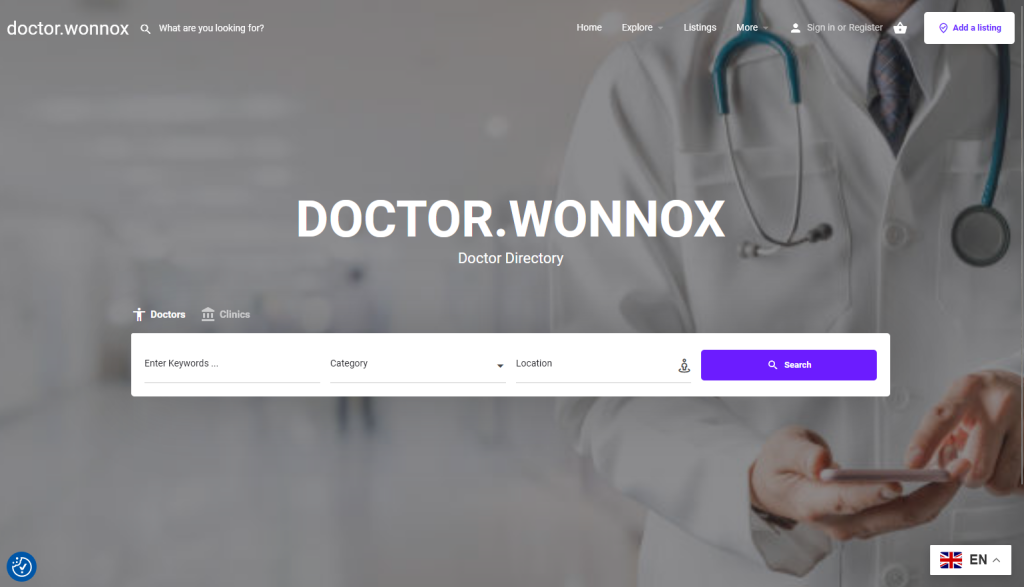
- Direct message
- Leave a review
- Bookmark
- Share
- Report
- prev
- next
Description
Creating an effective and comprehensive doctor listing in a web directory under the "doctor" category requires a balance of essential details, professional credentials, and user-friendly features. This profile should convey the doctor's expertise, specialties, and approach to patient care while making it easy for potential patients to access necessary information. Here’s an in-depth guide to the key features that should be included in such a listing:
1. Doctor Overview
Name and Title: The doctor's full name along with their professional title (e.g., MD, DO, DDS, PhD) should be clearly displayed. This is the first element that builds trust and credibility.
Professional Photo: A high-resolution, professional headshot of the doctor helps personalize the profile and establish a sense of approachability.
Tagline or Specialty Focus: A brief tagline highlighting the doctor’s area of focus or philosophy of care (e.g., “Compassionate Pediatric Care” or “Specialist in Minimally Invasive Surgery”).
2. Contact Information and Location
Practice Address: Full address of the clinic or hospital where the doctor practices, ideally integrated with an interactive map like Google Maps, making it easy for patients to find the location.
Phone Number: A click-to-call feature allows potential patients to easily make appointments or inquiries directly from their mobile devices.
Email Address: An email option for booking appointments or general inquiries, providing another avenue for patient communication.
Website Link: A link to the doctor’s or practice’s official website, where users can find more detailed information.
Office Hours: Clear office hours for each day, including information on weekends, holidays, and any emergency or after-hours availability.
3. Professional Qualifications
Education and Training: List of educational institutions attended, degrees earned, and any specialized training. This information helps build trust and demonstrates the doctor's expertise.
Certifications and Board Memberships: Details about certifications, such as board certification in a specific specialty (e.g., American Board of Pediatrics), membership in professional organizations, or other credentials.
Years of Experience: Including the number of years in practice can provide reassurance to patients seeking a seasoned professional.
Specialties and Sub-Specialties: Clearly define areas of specialization (e.g., cardiology, dermatology, family medicine) to help patients find the right type of care.
4. Services and Treatments Offered
List of Services: A comprehensive list of medical services and treatments provided, such as:Routine check-ups and physicals.
Specialized treatments (e.g., diabetes management, allergy testing).
Surgical procedures, if applicable.
Diagnostic tests and screenings (e.g., EKG, blood tests).
Treatment Philosophy: A short description of the doctor’s approach to patient care, such as a focus on holistic medicine, preventive care, or evidence-based treatments.
Telemedicine Services: Information on virtual consultations, including the platforms used and how patients can schedule an online appointment.
5. Patient Reviews and Ratings
Patient Testimonials: Featuring positive reviews can help build trust with potential patients. Highlight testimonials that emphasize care quality, bedside manner, and successful outcomes.
Star Ratings: An average rating from review platforms like Google, Healthgrades, or RateMDs provides a quick overview of patient satisfaction.
Response to Reviews: A feature that allows doctors or their practice managers to respond to patient feedback, demonstrating engagement and a commitment to improving patient experiences.
6. Insurance and Payment Information
Accepted Insurance Providers: A detailed list of insurance plans accepted by the doctor’s practice, helping patients determine if their visit will be covered.
Payment Options: Information about accepted payment methods, such as major credit cards, checks, or digital payment platforms.
Self-Pay Rates: If available, display rates for patients who do not have insurance, such as the cost of a standard visit, initial consultation, or follow-up visits.
7. Appointment Scheduling
Online Booking System: Integration with appointment scheduling systems (e.g., Zocdoc, Practo) or a custom scheduling feature allows patients to book appointments directly from the listing.
Wait Times: If possible, provide information on estimated wait times or availability for new patients, making it easier for patients to plan their visit.
Appointment Types: Clarify the types of appointments available, such as initial consultations, follow-up visits, telehealth sessions, or specific procedures.
8. About the Doctor
Professional Biography: A narrative that provides insight into the doctor’s career, what inspired them to pursue medicine, and any personal interests related to patient care.
Mission Statement: A short statement that expresses the doctor’s commitment to patient health, their approach to treatment, and the values that guide their practice.
Community Involvement: Information about participation in local health initiatives, volunteer work, or partnerships with community health programs can build a positive image.
9. Special Patient Resources
Patient Education: Links to blog posts, articles, or videos about common conditions, treatments, or preventive care tips.
Downloadable Forms: Forms that patients can fill out before their appointment, such as new patient registration or consent forms.
Pre-Visit Information: Tips for what patients should bring or expect during their visit, including preparation for specific procedures or tests.
10. Visual Content
Clinic or Office Photos: High-quality photos of the practice’s waiting area, consultation rooms, and diagnostic equipment. These images can help reassure patients about the environment.
Video Introductions: A short video where the doctor introduces themselves, explains their approach to care, and what patients can expect during their visit.
Procedure Videos: Brief clips explaining common procedures or treatments, helping patients understand what might be involved in their care.
11. Languages Spoken
Multilingual Support: List all languages spoken by the doctor and staff to attract a diverse patient base. This can be crucial for non-native speakers seeking care.
Interpreter Services: Information on whether interpreter services are available for patients who need additional language support.
12. Accessibility and Facilities
Parking Information: Details about parking availability, including any reserved spots for patients or nearby parking garages.
Accessibility Features: Information about wheelchair access, availability of ramps, accessible restrooms, and other features that accommodate patients with disabilities.
Public Transport Access: Information about nearby public transport options, making it easier for patients without cars to reach the clinic.
13. Social Media Integration
Social Media Links: Links to the doctor’s or practice’s social media profiles (e.g., LinkedIn, Facebook, Instagram) where patients can stay updated on health tips or clinic news.
Patient Engagement: Sharing posts or updates about health awareness days, seasonal health tips, or new services available at the clinic.
14. Certifications and Awards
Professional Awards: Display any awards or recognitions the doctor has received, such as “Top Doctor” lists or community service awards, to enhance credibility.
Special Achievements: Highlight notable achievements, such as contributions to medical research or involvement in clinical trials.
15. SEO Optimization
Keyword Optimization: Use relevant keywords like “best dermatologist,” “family doctor near me,” or “pediatrician in [city]” to improve the listing's search visibility.
Meta Description: A concise meta description that can appear in search engine results, offering a quick summary of the doctor’s specialties and services.
Location-Based Keywords: Including specific details about the neighborhood or nearby landmarks to attract local search traffic.
Conclusion
A well-rounded doctor listing in a web directory should combine professional details with engaging content to attract and inform potential patients. It should make it easy for patients to understand the doctor’s expertise, access contact details, schedule appointments, and feel confident in their choice. By providing a user-friendly, informative, and visually appealing profile, a doctor can effectively reach out to those seeking medical care, ensuring that patients have all the information they need for a positive healthcare experience. A robust online presence not only draws in new patients but also sets the stage for building long-term, trusted relationships in the community.

Add a review